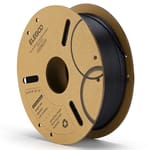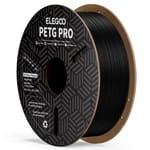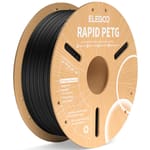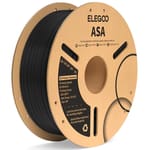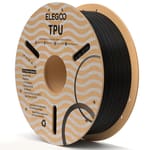Elegoo is a company with a unique path. They started by producing resin printers and resins, later entering the world of fused deposition modeling (FDM) machines, and have since expanded their offering to filaments.
One of Elegoo’s main objectives is to provide a good product at a low price, which is reflected in their filament production. These materials are among the cheapest one can find, with bundles that feature exceptional prices. The company claims an excellent tolerance of ±0.02 mm, which is usually offered by premium filament brands.
The brand’s filaments can be used on any machine, but they’re especially suitable for Elegoo printer owners, since the print profiles are optimized for the materials. If you own a Neptune machine, this might just be your best choice. But you can also use it with Bambu Lab’s Automatic Material System (AMS) by printing the filament ring that Elegoo has designed for its spools, or any of the community mods aimed at the same goal.
At time of writing, Elegoo offers exclusively 1-kg spools with a diameter of 1.75 mm – making them compatible with the vast majority of consumer machines. Unfortunately, you can’t buy samples right now, but since the spools are so cheap, you can try one before buying in bulk.
In this guide we’ll take a look at the filaments offered by the company, including information about the community experience, the best settings, and the variety.
Is this accessible filament worth it? Let’s find out!
PLA

PLA is arguably the most common and most used material on the FDM 3D printing scene. It’s the easiest filament to print and it’s a great option to start dipping your toes into this world with. Furthermore, since it’s so popular, you can choose between a wide variety of colors and effects. In fact, Elegoo offers numerous colors and variations of PLA. In addition to the normal PLA, you can find more engineered options, like PLA+, Rapid PLA, and PLA PRO, and others that are more aesthetic or aimed at other uses, like Silk, Matte, Marble, and Wood PLA.
These types of filament have distinct purposes. PLA+ is the next stop after basic PLA since it offers great printability with slightly more strength. PLA PRO has a similar goal, providing greater durability with higher resistance to mechanical stress, with less deformation. Rapid PLA+ was designed for high-speed printing thanks to the speed at which it heats up and melts.
On the more aesthetic side of the spectrum, Silk PLA is a type of material that has a shiny finish, with an effect similar to metal luster. The opposite is true for Matte PLA, which leaves an opaque surface on prints. Finally, the Marble and Wood variations are composites that afford your prints a look worthy of statues and famous talking trees.
With a rating of 4.4 stars and over 4,900 reviews at Amazon alone, we can safely say that this filament is quite popular. Makers share a particular appreciation for the price-quality ratio and the variety of colors available. Furthermore, some users have encountered problems with a batch of spools and have noted that Elegoo support was responsive and replaced the filament.
- Colors: 30, including sea green, sky blue, galaxy purple, and clear
- Recommended settings: Hot end 190-220 °C (Silk colors 200-220 °C), heated bed 50-65 °C
- Price per kg: $14-$20 (depending on color)
Variations
- Basics: PLA+
- Aesthetic: Silk, Matte
- Composite: Marble, Wood
- Specialty: Rapid PLA+, PLA PRO
PETG
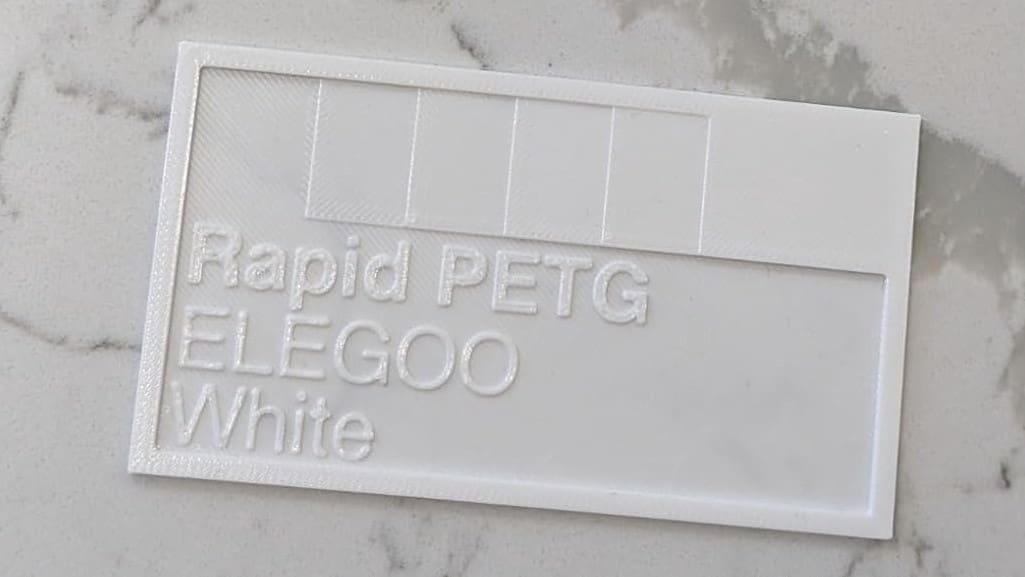
Although not as popular as PLA, PETG is still one of the most common filaments on the market. It is usually the first material you try after being accustomed to PLA. It offers higher UV and heat resistance and can be used for a variety of useful designs.
Elegoo offers two varieties of PETG: PETG PRO and Rapid PETG. PETG PRO aims to be easy to print while performing better, mechanically speaking, than normal PETG. Rapid PETG was designed to be used on high-speed printers, offering an improved flow that won’t decrease the mechanical properties of the material.
At Amazon, Rapid PETG also has a 4.4-star average from over 650 ratings. People have also noticed that it doesn’t absorb moisture as quickly as many other competitors on the market, making it easier to avoid stringing and blobs. Users have also observed that Rapid PETG flows really well and quickly, so you either have to increase the print speed or decrease the print temperature for best results.
- Colors: 6 (PRO), including pink, red, and silver; 12 (Rapid), including red, orange, and transparent
- Recommended settings: Hot end 230-260 °C, heated bed 70-90 °C
- Price per kg: ~$14
ASA
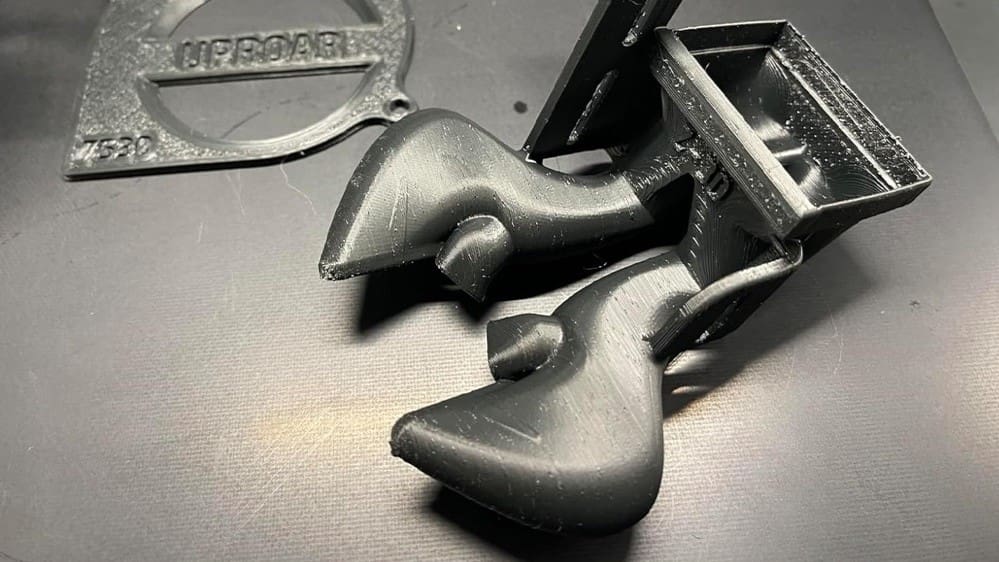
ASA is another step up from PETG. Elegoo offers this filament but in only two colors at the moment: the classic white and black options. Because this material is mainly used for functional prints rather than aesthetic ones, these should be sufficient. If you’re aiming for looks as well as functionality, you can obtain a great finish by smoothing it with acetone, like ABS.
ASA offers great UV resistance, temperature resistance, and mechanical properties. If you’re planning on printing something for outdoor use, this is the filament that is most indicated.
ASA can be a little challenging to print. The most common problem that you may encounter is bed adhesion but, as an Amazon user suggested, a little bit of glue and a raft should do the trick. Furthermore, ASA fumes are toxic, so an enclosure with a good ventilation system are very much recommended.
A problem that you may encounter is moisture. ASA is a hygroscopic material and easily absorbs humidity. Unfortunately, some users have experienced wet filament out of the box so you should consider drying it before printing. You can dry it at 65 °C for 4-6 hours to reach great results.
- Colors: Black, white
- Recommended settings: Hot end 240-260 °C, heated bed (with PVP glue) 75-95 °C
- Price per kg: ~$17
TPU
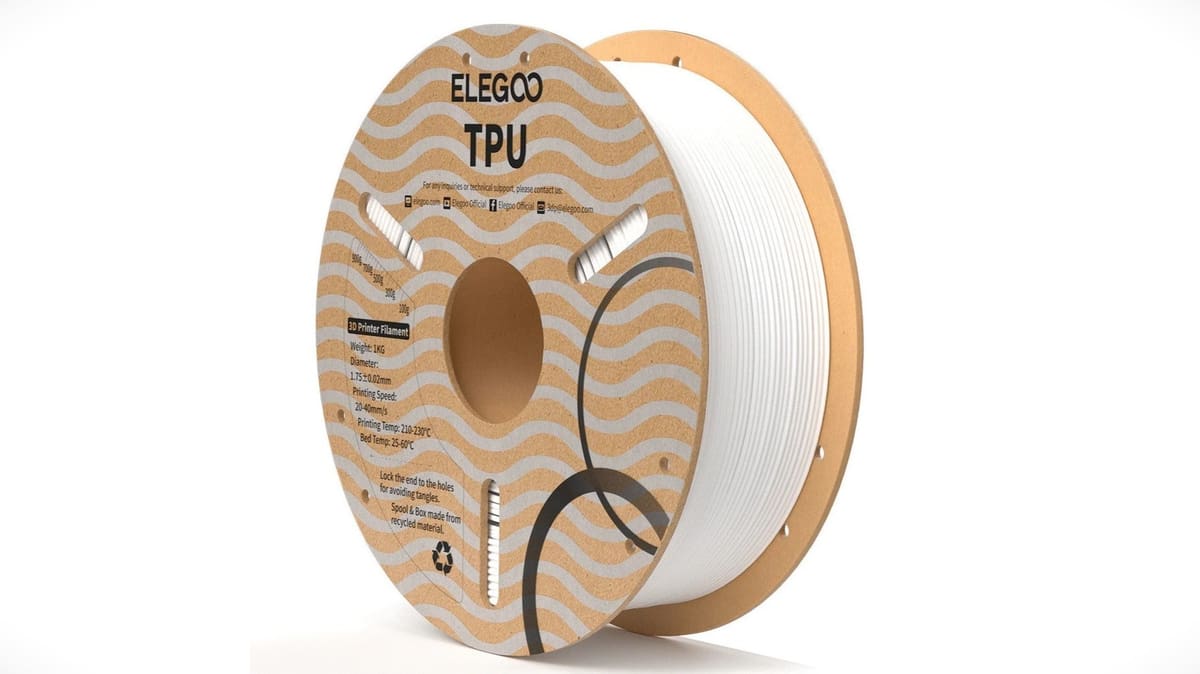
Finally, let’s talk about one of the strangest yet coolest materials that you can 3D print: TPU. This filament offers a unique property: flexibility. For this reason, it’s a little bit more expensive compared to the other filaments that we have talked about in this article. As with ASA, Elegoo offers only white and black TPU at the time of writing. Furthermore, Elegoo produces 95A TPU, which isn’t the softest you can find on the market but it’s the most common type and the easiest to print, even with a Bowden setup.
This material can be tricky to print since it’s flexible and absorbs moisture easily. For this reason, the key factors when opting for this material are drying and speed. Before printing it, you should dry it at 70 °C for 7-9 hours to avoid stringing and blobs. You also need to drastically decrease the print speed to avoid clogging. For this reason, a value between 5 and 30 mm/s is usually recommended. You should also lower the retraction settings to 1 mm at 60 mm/s.
While these are the general recommended values, you might need to tweak the print profile to obtain the best result possible using different calibration prints, such as the temperature tower and the retraction test.
- Colors: Black, white
- Recommended settings: Hot end 210-230 °C, heated bed 25-60 °C
- Price per kg: ~$19
License: The text of "Elegoo Filament: Buyer’s Guide" by All3DP is licensed under a Creative Commons Attribution 4.0 International License.
CERTAIN CONTENT THAT APPEARS ON THIS SITE COMES FROM AMAZON. THIS CONTENT IS PROVIDED ‘AS IS’ AND IS SUBJECT TO CHANGE OR REMOVAL AT ANY TIME.

